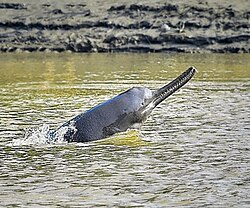Indian dolphin
| Indian dolphin | |
|---|---|

| |
| Ganges river dolphin breaking the surface | |
| Scientific classification | |
| : | [[Template:Taxonomy/Platanista]] Wagler, 1830 |
| Type species | |
| Delphinus gangeticus[2] Lebeck, 1801
| |
| Species | |

| |
| Current ranges of the Indus river dolphin and Ganges river dolphin | |
Indian dolphins, belonging to the genus Platanista, are toothed whales found in the waterways of the Indian subcontinent. Historically, they were regarded as a single species (P. gangetica), with the Ganges river dolphin and the Indus river dolphin considered subspecies (P. g. gangetica and P. g. minor respectively). However, due to genetic and morphological studies, they were reclassified as distinct species in 2021. It is estimated that the Ganges and Indus river dolphins diverged around 5,50,000 years ago. These dolphins are the sole surviving members of the family Platanistidae and the superfamily Platanistoidea. Fossils of their ancient ancestors have been traced back to the late Oligocene period.
Taxonomy
Indian river dolphins were historically classified as a single species, known as Platanista gangetica, with the populations in the Ganges and Indus Rivers recognised as subspecies (P. g. gangetica and P. g. minor, respectively). In 1801, Heinrich Julius Lebeck named the Ganges river dolphin Delphinus gangeticus, while Johann Georg Wagler introduced the genus name Platanista in 1830. This Latin term is believed to be derived from the Greek "platanistēs", potentially linked to the Greek words platē (meaning "oar") or platē (meaning "flat" or "broad"). The name was originally attributed to the Ganges dolphin by Pliny the Elder in his work Naturalis Historia around 77 CE. Later, in 1853, Richard Owen examined a specimen from the Indus and identified it as the same species as the Ganges river dolphin, albeit a smaller variant.
In the 1970s, scientists classified Indian river dolphins as separate species based on variations in skull and vertebral structures, as well as differences in blood proteins and lipids. However, these findings faced criticism due to limited sample sizes and a lack of statistical analysis. By the late 1990s, the two populations were once again regarded as subspecies of a single species. A mitochondrial DNA study conducted in 2014 indicated that there were not enough differences to justify their separation as distinct species. Nevertheless, a study in 2021 reassessed the two populations and identified significant genetic divergence along with considerable differences in skull morphology, ultimately confirming that they are indeed separate species.
References
- ↑ "Platanista Wagler 1830 (toothed whale)". Paleobiology Database. Archived from the original on 12 December 2021. Retrieved 26 March 2018.
- ↑ Template:MSW3